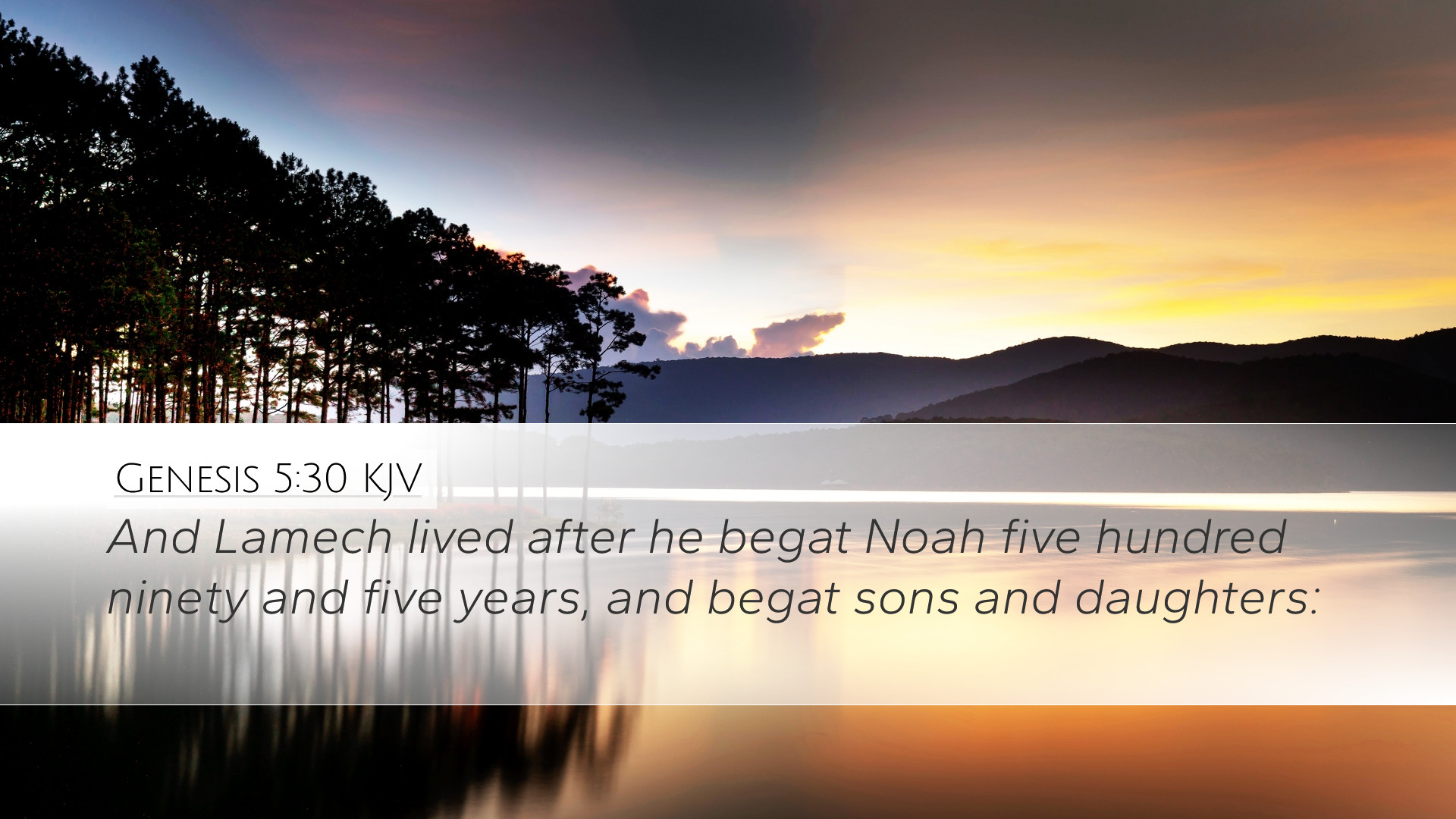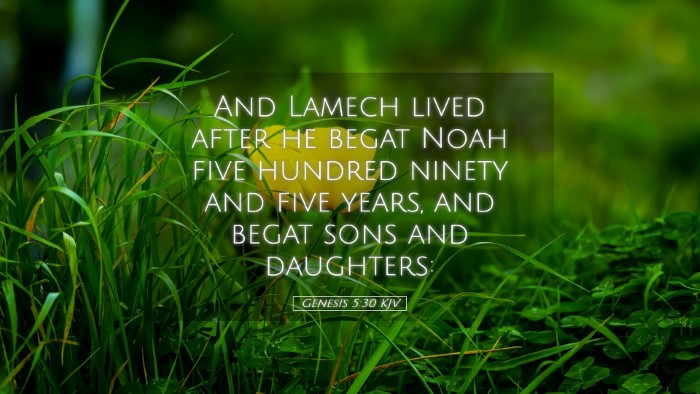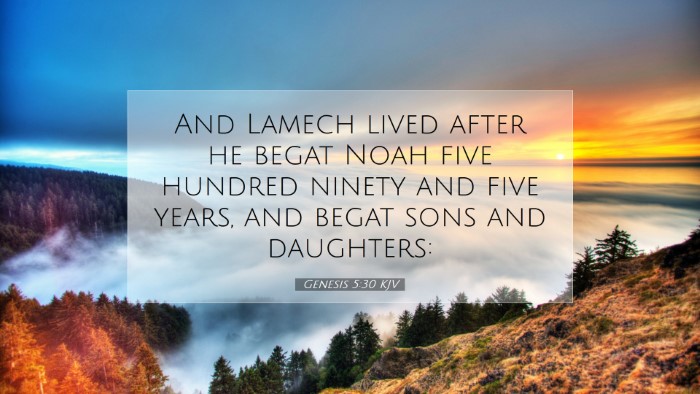Commentary on Genesis 5:30
Genesis 5:30 states, "And Lamech lived after he begat Noah five hundred ninety and five years, and begat sons and daughters." This simple yet profound verse marks a notable moment in the genealogical record presented in Genesis 5, which is replete with significant theological implications and historical context.
Overview of Genesis 5 Context
The fifth chapter of Genesis comprises the genealogy from Adam to Noah. This lineage is crucial for understanding the continuity of God’s covenantal promise through generations, illustrating how divine purpose unfolds over time. Each name carries weight, with Lamech being an important figure in the lineage leading to Noah, whose story is pivotal in redemptive history.
Analysis of Lamech
Lamech is presented in verses 28-31 as the son of Methuselah and the father of Noah. Two key aspects about Lamech are notable:
- Longevity: Lamech’s lifespan, living 777 years as recorded in Genesis 5:31, is indicative of the antediluvian age of humanity, characterized by prolonged life spans as part of God’s original creation order.
- Father of Noah: The verse emphasizes Lamech's role in the lineage that God would mark for preservation through the flood. Noah's birth is seen as a pivotal event: Lamech names him with prophetic significance, suggesting hope and comfort amid the increasing wickedness of the world.
Thematic Insights
The mention of Lamech begetting Noah encapsulates several core themes relevant to pastoral care, theological education, and biblical scholarship:
-
The Theme of Hope:
Amidst the declension of humanity towards evil, the birth of Noah provides a ray of hope. Matthew Henry notes that Noah’s name implies rest or comfort, highlighting God’s promise to bring relief from the curse—a reminder for believers of God's faithfulness in preserving a remnant.
-
The Importance of Legacy:
Each generation plays a critical role in God’s overarching plan. Lamech’s life, with a long lifespan marked by procreation, symbolizes the continuation of divine lineage and the importance of raising godly offspring. Adam Clarke emphasizes that family continuity is vital in God’s redemptive history.
-
Warning Against Corruption:
The genealogy serves as a backdrop against which the wickedness of humanity intensifies. Lamech lived in an era where corruption abounded, serving as a potent reminder for contemporary believers to remain vigilant against moral decay. Albert Barnes indicates that understanding the historical context of Lamech can inform the current generation to be watchful and live righteously.
Exegetical Considerations
In examining Genesis 5:30, scholars must consider linguistic and cultural contexts that inform our understanding:
-
Linguistic Analysis:
The Hebrew term for “begat” (ילד) implies the act of procreation and establishes a familial relationship essential for understanding covenantal continuity. The dual references to sons and daughters showcase the broad familial structure that God values.
-
Cultural Context:
The societal norm in ancient Near Eastern cultures placed a tremendous emphasis on lineage and family, as one’s legacy was often tied to descendants. Lamech’s significance is accentuated within this cultural framework, establishing a norm that contemporary readers can appreciate in light of our own familial and communal identities.
Theological Implications
This verse also opens up a discussion of overarching theological themes, such as redemption and continuity:
-
The Redemptive Plan:
As Lamech transitions in history, he heralds God’s redemptive plan culminating in Noah, a type and precursor of the salvation narrative leading to Christ. The perpetuity of God's promise through a seemingly obscure genealogy emphasizes God's sovereignty in history.
-
The Nature of God:
Throughout this genealogy, God’s unfailing faithfulness and interaction with humanity are evident. Lamech's recognition of Noah's potential as a servant of God reflects a theological acknowledgment of God’s providence in the affairs of man.
Practical Application
For pastors and theologians, Genesis 5:30 necessitates a thoughtful reflection on the dynamics of godly legacy and the responsibilities that follow:
-
Family and Evangelism:
Like Lamech, today’s individuals are called to build families rooted in the fear of the Lord, understanding that our children and those we mentor can be instruments of God’s grace and hope.
-
Vigilance Against Cultural Decay:
In light of Lamech's epoch, which witnessed moral decline, contemporary believers must strive to uphold values and truths that align with biblical doctrine, actively contributing to the well-being of society at large.
-
Hope in God's Sovereignty:
When encountering troubling times analogous to Lamech's era, we are reminded to hold fast to the expectation that God brings forth hope and restoration as seen in Noah.
Conclusion
In summary, Genesis 5:30 serves as a critical junction in the biblical narrative, foundational to understanding God's interactions with humanity. Lamech's life, his prophetic words concerning Noah, and the implications of his extended family reflect God's enduring promises and faithfulness. This commentary synthesizes insights from notable biblical scholars, reminding the church today of the importance of lineage, hope, and the responsibilities that come with our faith.


